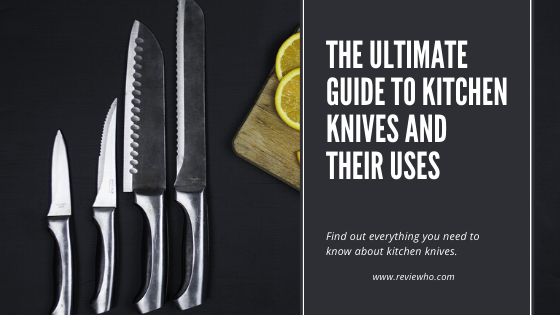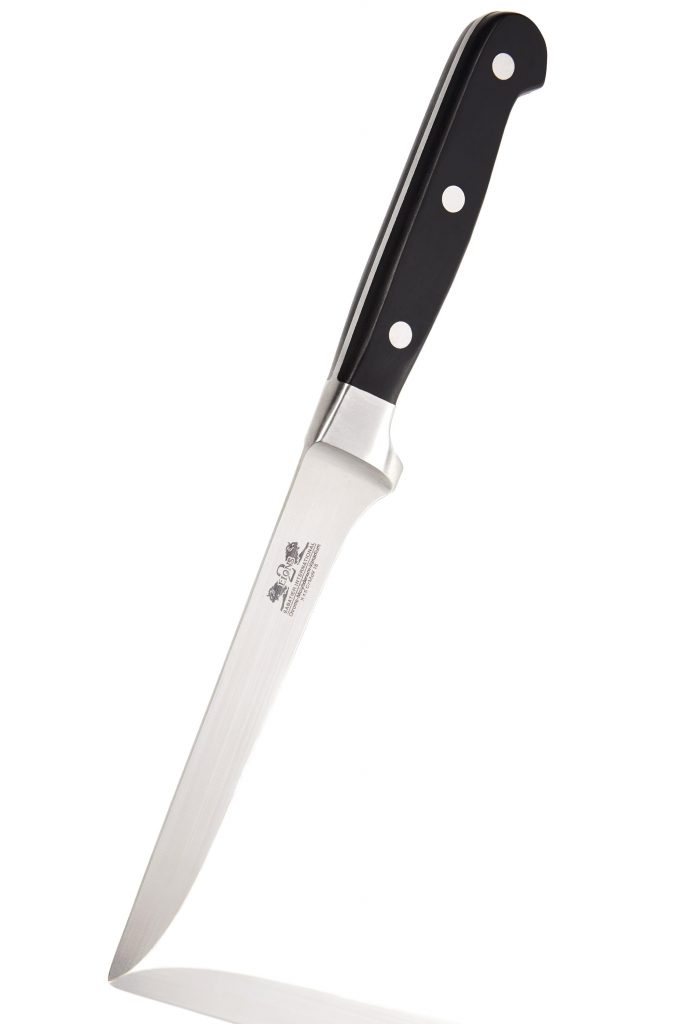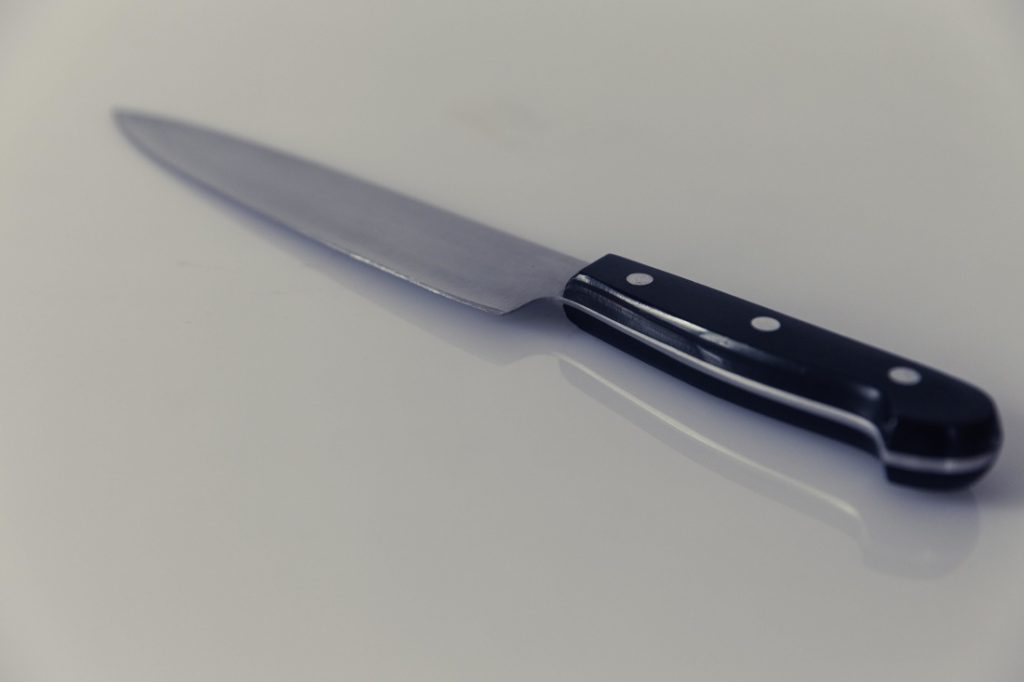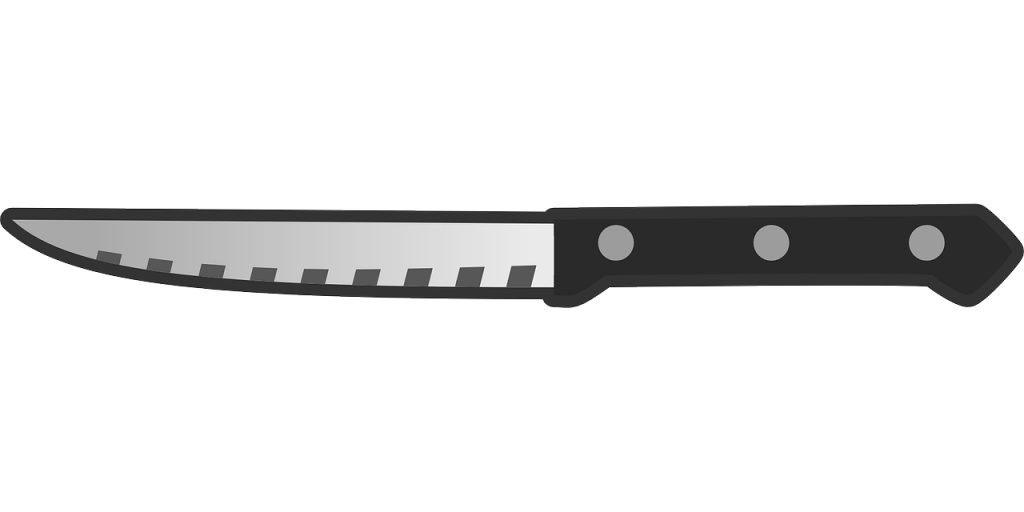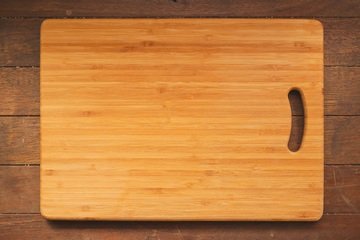Boning Knife
A boning knife is a special style of kitchen knife designed to help you with food preparation by removing bones meat, poultry, and fish.
Because of this purpose, it usually comes with a narrow blade. Some boning knives can be flexible, but others are stiff. They also tend to have sharp and slender points.
Typically, the blade of a boning knife measures about 5 to 6-1/2 inches in terms of length, although many brands can go as long as 9-12 inches.
The thin profile of the boning knife helps in making precision boning easier, particularly for making deep holes and cuts.
The stiff boning knives are better used for boning pork and beef, while the flexible ones are better used for fish and poultry.
What are the uses of a boning knife? Is it really necessary for the average kitchen?
For an amateur cook, it probably will not be necessary. However, there will always be times when you will feel like cooking with fillet pieces instead of meat pieces with the bones in them.
Having the correct knife to use will ensure that you get the most meat out of your pieces, with as little as possible sticking to the bone.
Also, having the correct knife means that you will wind up with a fillet piece that is still one solid piece, instead of having the meat all mashed up and chopped up into tiny pieces that will only work for a stir fry!
If you are thinking of getting a new kitchen knife set, it might be a good idea to consider one that comes with a boning knife.
J.A. Henckels International Forged Premio 19-piece Knife Set is one example, coming with a 6-inch boning knife or you can read more set reviews by clicking here.
The set is also a wise choice for major Thanksgiving dinners, as it also comes with poultry shears, a salmon or ham slicer, a carving fork, and a carving knife.
Alternatively, some homemakers who do not really need a dedicated boning knife, such as those who do not really perform deboning tasks on a regular basis, can do well with boning tasks using a multi-utility knife.
For example, many reviewers were happy with the Pure Komachi 2 Series Serrated Multi-Utility Knife, as they found it to be quite effective in terms of trimming excess fat and boning meat. With its flexible tip, this knife is easy to use for deboning fish and even de-veining shrimp.
A third option for deboning tasks when there is no dedicated boning knife is the paring knife. Many serious chefs can swear by paring knives as an effective alternative for boning tasks, of course, in the absence of boning knives.
However, since most paring knives come in much shorter lengths, like 3-1/2 inches and 4 inches, they probably will only work for deboning chicken and fish, and not really be any help for pork and beef. In fact, even for chicken, the boning can only be done when the chicken is already chopped up in more manageable pieces since the blade length is a strong limitation.
An important thing to remember, too, about boning knives, is that you need to use knives made of stainless steel or high carbon stainless steel.
If ever you will be reaching for a knife that is not intended for boning, be sure that you are not using a ceramic knife. This is because the boning task provides many an opportunity to hit your knife across the bone, which may cause ceramic blades to chip.
While the set comes with a paring knife that is supposedly a good enough substitute, for this particular knife set, which is made of ceramic, users warned against certain kitchen tasks, including boning and anything involving a prying motion.
Once you understand the true purpose of a boning knife, you will likely be better off buying a dedicated knife for that purpose.
Knowing this will help you make a wiser decision in your future kitchen knife set purchases, as you can make sure the set comes with a boning knife right from the outset.
This way, you also will not compromise the function of all the other knives in your collection.
Butcher Knives
A person who deals with knives on a regular basis will definitely need the best quality tools designed for his particular trade. For example, a chef will need reliable kitchen knives for all his cooking preparations, but the same knives may not be enough for his needs.
As such, most chefs will likely have several different sizes and kinds of the knife to make their food preparation task go much faster and easier, while also providing him the greatest possible comfort throughout long hours of work.
Butchers are no different from chefs in that they generally have their loyalties stuck to their favorite knife brands or types.
Since butchers typically handle a bigger task, butcher knives will generally be bigger than a regular chef’s knife.
A chef knife can come with blades measuring six or eight inches, with some going as long as 10 inches, like the Wusthof Classic Wide Cook’s Knife.
This longer chef knife can be a good choice for butchers, as it is more capable of cutting larger pieces of meat along with their bones.
Given how butcher tasks typically deal with much bone cutting, a cleaver is also a good tool to have, thanks to its wider blade.
The wider blade offers greater strength for chopping motions. When looking for a cleaver, you need to choose one with a blade made of high carbon stainless steel, as this is the material that is less prone to staining and rusting.
Next, make sure that the blade is constructed in a full-tang design. When the blade material goes all the way through the handle, you are assured of greater strength and stability.
For example, the cleaver and the other knives in the Ginsu 4816 16-Piece Stainless-Steel Knife Set is a reliable tools for people who do much cutting and chopping regularly.
An important thing to remember about butcher knives is that you need to know how to care for them properly.
Even when you have the best quality knife in your possession, if you do not take proper care of it, you will likely be left with a poorly-performing knife.
What are the things you need to consider when maintaining your butcher’s knife?
- Use the right chopping boards for your needs. From the different materials that chopping boards are made of, you can actually choose anything, from plastic to tempered glass, to wooden boards, but tempered glass tends to be the roughest on knife blades. As such, if you do not have any specific preference for tempered glass board, your knife will likely fare better with a plastic or wooden board.
- Observe proper cleaning procedures. High-quality knives typically require washing by hand and then drying afterward before storing. Some knives may be described as dishwasher-safe, but experts generally frown on them. For example, some knives may have some reviewers complaining about rusting after only a few months’ use, but often it turns out that they actually did not observe the required maintenance procedures, which resulted in the knife rusting prematurely.
- Keep your knives properly sharpened. Knives, no matter how expensive they are, still tend to dull out after some time. For stainless steel knives, you can generally sharpen them using a sharpening rod.
If you have an electric knife sharpener, be sure you do not over-sharpen it, as is usually the case with busy chefs who sharpen their knives while multi-tasking. This puts your knife at risk of having more of its steel ground off than you probably need, which inevitably shortens the useful life of your knife. Remember that leaving your knife dull poses a greater risk for you, as a dull knife not only requires greater force to achieve the same cutting results, and also has a greater tendency to slip while you are cutting, giving you a high risk of injury.
When you understand these basic care procedures for your butcher knives, you will likely find that they can last you a very long while. This assures you that any investment you make on a kitchen knife will be very well worth it, as it can last and serve you for many months and even years to come, giving you efficient cutting experiences time and time again.
Steak Knife
The presence of certain cutlery and kitchen supplies in a certain household’s cupboard is a nice glimpse into the lifestyle of the family.
For example, casual families that enjoy barbecues and burger dinners will likely not have much silverware, yet will have piles of paper table napkins ready for use.
A family that enjoys sit-down dinners at regular intervals will likely have cloth table napkins out in easy reach, with utensils like soup spoons and dessert spoons are quite prominent.
Also, a steak knife may easily become a common sight beside every place setting.
Is a steak knife truly necessary for the average household? Yes, and no. For families who love get-togethers with formal settings, a steak knife is a definite must-have.
But for those who typically eat out or buy take-out, they will likely survive quite well enough without a single steak knife.
Then again, a steak knife can go with barbecues just as well, especially when they feel like upping the setting a bit once in a while and toss a steak into the grill.
How many steak knives do you really need? Again, the answer depends on your particular lifestyle.
Families who enjoy entertaining in a formal setting will do well to count the average number of guests that they might have for a sit-down dinner: for example, if the dining table seats eight, it would be wise to have eight steak knives, such as the Calphalon Contemporary 8-Piece Stamped Steak Knife Set.
Having more than that would have no clear purpose: after all, a steak knife can only be properly used against the solid base of a dinner table.
If you happen to enjoy entertaining but prefer a more laid-back feel, like a dance party where everyone just lounges around on any part of the house, with a buffet table all set up but no real sit-down dinner, a set of steak knives may not be that necessary to layout for all the guests to use.
Instead, you can just toss in a couple of steak knives as serving utensils for your steak or roast beef, so that the guests have an easier time slicing the meat. The same can be said for families who love throwing barbecue parties: a steak knife or two can come in handy for slicing up steaks that you grill up for people to share.
For these kinds of families, you can choose a knife set that comes with steak knives, such as the J.A. Henckels International Everedge 13-Piece Knife Set, which prevents any serious pondering on the steak knives themselves and yet gives you the option if ever the situation calls for it.
For example, if you are generally very casual, you may suddenly opt for a romantic home-cooked dinner on Valentine’s Day, or a special event, like a marriage proposal or a special anniversary. Of course, other cutlery like formal silverware may be necessary, but these will be easier to come by, along with cloth table napkins and glass stemware.
Oh, and don’t forget the candles and flowers!
On the further extreme, there are some families who hardly ever, if at all, host a gathering at their house.
These are the households who are either too busy to clean up the house and cook a proper meal, and therefore rely much on takeout food and eating out, or are too much of an introvert to want to have friends over.
For these kinds of families, a steak knife will likely just add to the clutter in the kitchen. If you are thinking of giving a knife set to a family or couple that falls under this category, you may do well to opt for a knife set that does not come with a steak knife collection, like the Douglas Quikut Ginsu 5-Piece Stainless Knife Set.
On the other hand, if you are hoping to stir up some romantic mood in an otherwise party-pooper family, you can still give them a set with some steak knives to toss the idea forward!
Overall, a steak knife is a helpful addition to any kitchen cupboard, even for the mere fact that it gives the family an option to turn to if some pieces of meat are a little too tough to slice with a normal table knife.
Carving Board
A carving board is an important item in any kitchen. Not only does it provide a nice, level surface for carving meat, it also serves as the chopping platform for many a food preparation adventure, and may even be used for serving the finished output. These boards can double as a hot pad for certain food preparation finales.
Every kitchen needs at least one carving board, while others can even have as many as 4 to 5 of them, particularly for households that love meat.
The traditional carving board is made mostly of hardwoods, although in recent years, a new breed of boards has come out.
These boards, made of different materials, have their own advantages and disadvantages. The main concern about a carving board is whether it is prone to become a breeding ground for bacteria, or if it is relatively “safer.”
Some materials are also much easier to clean than others, although experts believe that the issue of contamination comes about more as a result of human action, or the absence thereof, in terms of cleaning the board up after use.
The following are the basic characteristics of the most common types of carving boards:
- Plastic carving boards – These are the most affordable and actually come in a range of colors, varying degrees of flexibility, and varying degrees of thickness. A flexible plastic carving board is best used for food transfer, and it is also the easiest to store. Of course, this type does not last as long as the thicker boards, because a knife can easily cut through the material. The hard plastic board is more durable. Plastic boards are viewed as less prone to food contamination because they are very easy to clean as well as sanitized; in fact, the smaller boards may even be washed in the dishwasher.
- Tempered glass boards – These carving boards are by far the most beautiful. They are also durable and resistant to heat. A major plus for these more expensive boards is that they are very easy to clean, making them the most sanitary. Unfortunately, glass also offers the greatest abuse on the edges of knife blades, and they really result in an annoying noise when slicing is done on them.
- Wooden boards – Wooden carving boards used to be made solely of maple hardwoods. These days, though, many other wood materials are used, including bamboo. Although bamboo is actually grass, its hardness and inherent resistance to bacteria have offered it a spot as a favorite material for knife blocks and carving boards. The major advantage of wooden boards is that they are the easiest on knife edges, and they give a nice chopping sound. If you are using a ceramic knife like the Kyocera Kyotop Damascus Pakka Handle Chef Knife, for example, you will be more confident to use a wooden board instead of a tempered glass one to avoid chipping! However, they are also the hardest to clean, and the cracks and cuts that come from chopping on them make them a serious breeding ground for bacteria.
No matter what type of material you choose for your carving board, you will likely still go through general care and guidelines to ensure the best fight against bacteria.
Remember to wash your boards in hot soapy water right after use, and also sanitize it occasionally with chlorine added to the water.
When boards sustain cuts and cracks, it is best to discard them and buy new ones. Also, be sure to dry the boards completely before you store them away.
Another important thing to remember when using carving boards is to avoid cross-contamination: this entails making sure that you do not slice cooked food on the same board and using the same knife that you used for chopping raw food.
If you are not the meticulous type, buying a color-coded knife set like the Pure Komachi 9-Piece Knife Set with Block may be a good starting point, as the different knives come in a specific color so you can avoid cross-contamination.
Now that you understand the basics of carving board options, maintenance, and food contamination avoidance, you will definitely soar in your kitchen endeavors with no worries about bacteria and microorganisms in your meals!
Also, Read:
- Best Sets of Kitchen Knives
- Best Chef’s Knives For The Money
- How to Care for and Maintain Your Kitchen Knives
Carving Knife
Families who are serious about get-togethers can never go many months without a carving knife.
After all, not only does Thanksgiving allow room for dad to put on a show about carving the turkey, other sit-down dinners need the appeal linked to having nice, slow-cooked roast beef or pork.
A carving knife falls under meat knives, and is a relatively large knife, measuring between 8 to 15 inches or 20 to 38 centimeters, whose main purpose is to make thin slices of meat and poultry.
In a sense, it belongs in the post-preparation side of cooking, making it not all the same as a chef’s knife, which is used for chopping and dicing and other pre-cooking tasks in the kitchen.
In terms of construction, a carving knife is thinner than a chef’s knife, especially at the spine, which enables it to make thinner and more precise slices.
They also tend to be shorter as well as wider than slicing knives, although some users feel that they are about the same as slicing knives; this may be the reason why users of the Chicago Cutlery Fusion 18 Piece Knife Set, for example, use the included slicing knife for carving meats and poultry with no problem at all.
A carving knife typically has a pointed or rounded tip, as well as a non-serrated, smooth blade.
The pointed tip makes it easy to cut around a bone, while the smooth blade makes it easy to make large slices of meat, like roast beef or ham.
A longer blade, such as that which measures 9 inches, makes it easier to slide back and forth with the least sawing motions. Fluted edges on the blade may also be a good addition, as it helps keep the meat from sticking to the blade.
If you and your family enjoy a roast beef special dinner, the International Fine Edge Synergy 17-Piece Knife Set is one set that you will definitely enjoy.
Not only does it include a dedicated carving knife, but it also comes with eight steak knives, allowing each guest to enjoy his meal with gusto.
The knives also come with rubberized and contoured plastic handles, making them very comfortable to hold; you also do not have to worry about the strength of the carving knife, as the set features full tang construction for all the knives, with triple rivets holding them in place.
Meanwhile, another possible consideration of investing in a carving knife would be who usually does the carving: if there is more than one man in the family who enjoys the carving tradition, or if you enjoy having guests do the carving once in a while, it may be a good idea to invest in knives that allow for left- and right-handed operation.
The Ginsu 4827 14-Piece Stainless Steel Knife Set, for example, comes with an 8-inch slicing knife you can use for carving, and this knife, along with everything else in the set, feature symmetric edge technology: this means that both sides of the knife come with matching serrations, assuring you of ambidextrous user-friendliness alongside the improved precision.
If your family enjoys a good sense of humor, you may actually find a nice carving knife in a unique set, Spartan Knife Set. This set is a unique kitchen knife set that features a knife holder shaped like a man, with the knives going through his shield.
Of course, this kind of knife set is not for the faint of heart, but the 8-inch carving knife it includes will definitely make for a great tool for Thanksgiving and Christmas dinners.
For families who do not mind a good laugh now and then, though, the carving knife will definitely not get much attention, as the knife holder, when placed in view of the dinner table, will definitely capture the spot as the conversation piece.
Given how the carving knife typically makes its appearance in special dinners and family gatherings, its function is basically as a well-trusted assistant to the perfect host and hostess.
As such, it would be a good idea to make sure that your knife is always well-sharpened, especially before the special occasion.
Cooking Knives
Cooking is a delightful task for anyone who appreciates the art behind chopping, slicing, mincing, dicing, and eventually taste testing and garnishing.
The invention of the knife may just have revolutionized the way that human beings cook their meals.
Instead of being limited to tossing things as-is into the pot, the cooking knife has made it easier to make dice and slices, affecting the way the food item is cooked, and eventually, the way it tastes.
For an amateur cook, a knife will always just be a knife, and there seems to be no difference between the materials, the shape, or the functionality of all the knives he sees.
But the following cooking knives have their distinct role in the art of cooking, and once you understand their specific purposes, you will be able to use them to the best of their potential, giving you room to soar in your food preparation:
- Chef’s knives – A chef’s knife is basically tasked with making chopping, dicing, and mincing activities in the kitchen. The usual length is 6 and 8 inches, although some go as long as 9 or 10 inches. If you are unsure about the length to get, 8 inches is a good number. Of course, if you have small hands, 6 inches may be better, but many 8-inch chef’s knives already make it a point to be as comfortable as possible for all hand sizes. The Calphalon Contemporary Chef’s Knife, for example, is a good choice of an 8-inch chef’s knife, thanks to its good balance and comfortable grip.
- Cleavers – The cleaver is designed for chopping through bones, such as when cutting poultry and tough pieces of uncooked meat. Cleavers are not generally included in kitchen knife sets, but you can easily buy one to add to your collection, particularly if you often need to cut up poultry through the bones. The Miracle Blade III 11 Piece Knife Set is one set that actually includes a cleaver, and this may be a good investment if you need a set with a cleaver.
- Santoku knives – The Santoku knife originated in Japan, and is designed to make chopping, dicing, and mincing an easy task. Many chefs swear by the versatility of the Santoku. If you have never used a Santoku knife before, you can try the Wusthof 4183-7 Classic 7-inch Santoku, and you will likely find your loyalties challenged, owing to the ease that Santoku knives boast of.
- Paring knives – A paring knife is designed to work on the smaller details in any kitchen preparation. Some chefs interchange it with a deboning knife, as it can be used to debone chicken and fish. One good example of a 3-1/2-inch paring knife with a good ergonomic design is the Oxo Good Grips Paring Knife, making the detailed kitchen tasks easier to do.
- Miscellaneous Knives – These knives are not too common, but they also serve their own place in the kitchen. For example, using an Oxo Good Grips Lettuce Knife is always a definite must for salad lovers, knowing how lettuce browns rather quickly when it comes in contact with steel. If you and your family happen to love shellfish, you can opt for oyster knives, too, so you can quickly open up your shellfish and toss them into a great casserole or stir fry.
- Ceramic knives – While these are not knives that serve a particular cooking purpose, they are worthy to mention for cooking concerns for one reason: some chefs dislike the taste of steel when preparing certain foods with uncooked garnishing. Ceramic knives are great choices for slicing tomatoes, cucumber, or any other ingredient you may need to toss on top of cooked food, as they do not leave an aftertaste. They also do not react with acids, oils, or salts in food. Of course, ceramic knives are more prone to breaking, and should only be used by cooks who are used to being careful. If you want to try it out, the Kyocera Revolution Series Utility Knife may be a good start, allowing you to slice fruits and vegetables as thinly as possible.
As you explore the different functions of the different types of cooking knives, you will soon find the entire experience of cooking to be a constant challenge, while being a great achievement on a daily basis.
Kitchen Knives Comparison:
Feel free to share your observations with me in the comments section!
Also, if you find the information in this post to be useful, be sure to share this post with your friends on Facebook, Twitter, and Pinterest!

